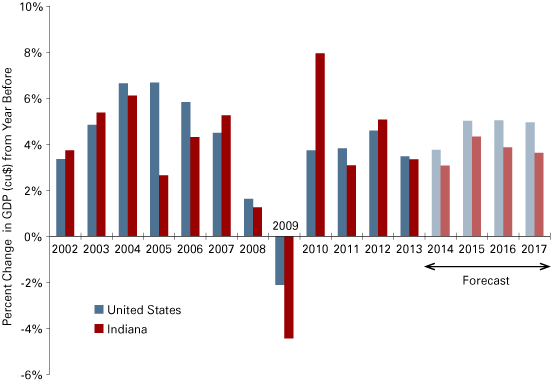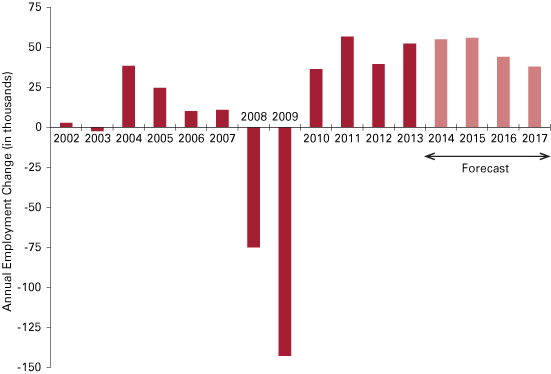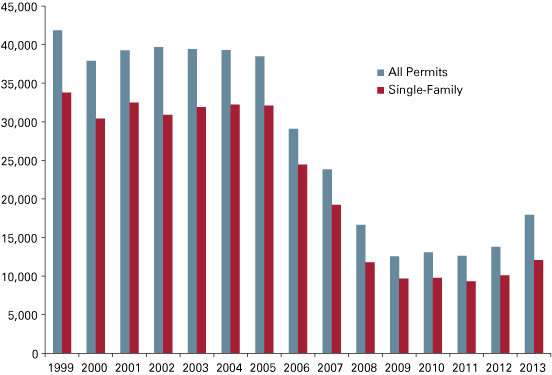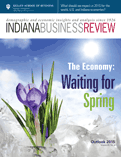Indiana's Outlook for 2015
Director of Economic Analysis, Indiana Business Research Center, Indiana University Kelley School of Business
In the fall of 2013, when we were trying to forecast the year ahead, the country was swirling in uncertainty. There was a partial government shutdown, debt ceiling talks had turned acrimonious, the Federal Reserve was about to get a new chairperson, the Affordable Care Act roll-out was botched, and to make matters worse, it was getting really cold outside.
We expected real economic growth in Indiana to be about 2.3 percent for 2014, about the same as the growth rate of 2013. Now, at the close of the year, we expect 2014 growth in the state to close out slightly better—closer to 3 percent—and that even accounts for the big economic freeze in the first quarter of 2014 when output stalled.
GDP Growth and Employment
Indiana’s gross domestic product (GDP) growth in current dollars (cu$) is expected to follow the nation in terms of direction, but at a slightly lower rate. Indiana’s GDP grew about twice as fast as the U.S. in 2010. In the three following years, Indiana’s economic output growth was similar to the U.S. with some slight variation. As Figure 1 shows, the 2013 growth rate was a tad behind the U.S. and 2014 is expected to close the year at just a fraction off the national rate. This trend—being just a step behind the national average growth rate—is forecasted to continue through 2017.
Figure 1: Annual Change in Indiana and U.S. Gross Domestic Product

Note: 2014 through 2017 data are projections.
Source: U.S. Bureau of Economic Analysis, Indiana University Center for Econometric Model Research and Indiana University Indiana Business Research Center
Forecasts are predicated on assumptions. Among other forces at play, two important drivers can make the state forecast either less or more rosy. Prospects of lower exports in 2014 and 2015—discussed in greater detail below—would reduce Indiana’s economic and employment growth performance, while the persistence of robust auto sales would help to buoy the state’s economic growth.
2014 turned out to be a great year for auto sales. At the time of this writing, the year is on track to hit over 16 million units. In August of 2014, monthly sales at the seasonally adjusted annual rate were over 17 million units, heights not attained since the middle of 2006. The prospects for 2015 look good as well. According to CNW Research, floor traffic for new cars in October was up 18.6 percent over October 2013. This indicates a likely jump in 2015 because shoppers typically don’t enter a dealership until two or three months before making a purchase. CNW Research also points to a fall in their “Jitters Index” (which is like the flipside of a consumer confidence measure) and notes that subprime approval rates are also on the rise, juicing sales.
Having digested the good news on the auto manufacturing front, one should keep in mind that the state’s fortunes don’t rise and fall with the auto sector. The state bounced back relatively strongly in 2010—twice the national rebound—even as auto sales hovered around a mere 11.5 million units.
Figure 2: Indiana Employment Growth

Source: U.S. Bureau of Labor Statistics, Indiana University Center for Econometric Model Research and Indiana University Indiana Business Research Center
On the employment front, the good news is that, in 2015, the state is set to return to the same level of peak employment from last decade. Regaining lost ground took longer than it should have. Initial employment gains weren’t brilliant. Last year, we expected to add 52,000 new jobs in 2014–a middling performance–but the state hit that mark by September and Indiana employment is set to exceed our forecast for 2014, with employment in the construction of buildings and transportation equipment manufacturing increasing by double digits.
Our forecast for 2015 is that the state will add 55,000 workers. The unemployment rate is expected to remain near 5.7 percent by 2014’s end. By the end of 2015, it should register 5.3 percent.
Exports
From 2012 to 2013, Indiana’s exports decreased 0.7 percent; meanwhile, exports grew by 2.2 percent nationally and 1.2 percent in the Midwest. Given that, relatively speaking, exports are more important to Indiana than other states, this drop is of some concern. Indiana’s economic output (GDP) ranks 16th in the country but its dependency on exports ranks 12th.
Transportation equipment and the life science industries (pharmaceuticals and medical instruments) are the leading export industries in Indiana. Most of Indiana’s export industries have had strong average annual growth over the last decade, notably aircraft, spacecraft and related parts; pharmaceuticals; iron, steel and related products; optical and medical instruments; and agricultural products.
If the weak economic growth that is expected in most of the eurozone continues—forecasted to be a mere 1.2 percent—it will reduce their demand for our exports. The exports to the eurozone and the United Kingdom are skewed toward pharmaceuticals, medical devices, industrial machinery and aircraft/space craft components. On the other hand, exports to Canada and Mexico are predominately auto vehicles and parts. As a result, Indiana’s auto sector exports position would not be as exposed to the risks associated with the European economic morass.
Up until recently, many looked to the emerging economies of the world as the force behind global economic growth and the concomitant increase in global appetite for U.S. goods. However, it appears that there is less potential for expanded export opportunities to the emerging markets in the near future. For example, the BRICS countries (Brazil, Russia, India, China and South Africa) are, as a group, not turning in the rates of growth experienced a couple of years ago. Moreover, trade between the U.S. and Russia may go from small to almost nil as a result of rising political tensions and the ripple effects of trade sanctions. All that to say: export growth in 2015 will not likely be the economic stimulus for Indiana that it was from 2010 to 2012.
Housing
Indiana housing market improvement has been choppy. Last year, sales were up 17.4 percent and average prices up 4.3 percent through September compared to the previous year. However, year-to-date (September 2013 vs. September 2014), sales were off 3.6 percent. This may reflect the fact that the market has been over-balanced by investors purchasing properties and is now transitioning to homebuyers, perhaps even first-time homebuyers.
Home construction continues to improve, albeit slowly. Building permits show slow but steady progress. Home builders are more optimistic than they have been since before the recession. They are seeing increasing traffic from prospective buyers wanting to get into a house before long-term mortgage rates close them out of the market. This brings us to a growth threat alert: the Federal Reserve has stated that they are changing course and will slow the flow of money into the markets, thereby increasing interest rates. Thirty-year mortgage rates track with 10-year Treasury securities. If rates rise too quickly, the fragile housing recovery will come to a halt.
Figure 3: Indiana Building Permits

Source: U.S. Census Bureau
Leading Index for Indiana
The Indiana Business Research Center’s Leading Index for Indiana (LII) is an index similar to the Conference Board’s Leading Economic Index for the nation, except the LII is designed based on the structure of Indiana’s economy.
The LII for October read 102.2, up a mere tenth of a point from a revised September reading of 102.1. The components of the October LII were in a tug of war. The Purchasing Managers Index (a measure of manufacturing sentiment) tugged the index down, while the transportation and auto sector components exerted slight upward pressure.
These measures of economic conditions have been shown, historically, to predict economic performance in the state about four to six months in the future. But the index does not account for supply shocks—either positive or negative. The drop in gasoline prices—a positive supply shock—can be likened to a small windfall for those watching every penny. To the degree that those pennies find their way to increased consumer spending, the Hoosier economy will get a boost.




